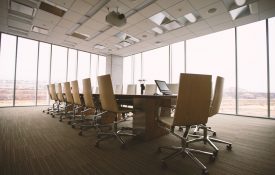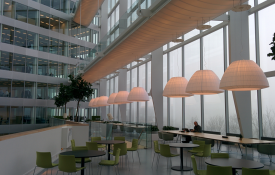Real estate is all about “location, location, location,” as the old adage goes. But it’s not always that easy when it comes time to picking the perfect site and property for your business operations.
Consider this: If your company is approaching the end of its current 10-year lease term this year, you probably selected your office before Apple released its first iPhone in 2007. Needless to say, things have changed dramatically in the past decade—including the factors you should be taking into account when selecting a location.
While some fundamental elements remain just as important today as they were a decade ago, there are several emerging trends you should take note of before your company gets locked into another long-term lease.
[To read more of R. Todd Doney’s thought leadership click here]
The ways in which today’s workforce commutes to work and a heightened awareness of the importance of health and wellness are two trends that are playing an increasingly prominent role in office space. Keep these factors in mind when picking your next location.
Evolution of Commuting
- The expanding Metro train system in Los Angeles has been a game-changer for many businesses, and it makes more sense than ever to open shop within walking distance to a Metro stop as a growing portion of today’s workforce has embraced public transportation.
- Separately, the rise of on-demand ridesharing services such as Uber and Lyft has given commuters yet another option. And while it might seem farfetched now, driverless cars may soon begin to play a prominent role in your real estate decision-making process. In fact, IHS Markit recently noted in a forecast that global autonomous car sales will reach 600,000 by 2025 – many of which will be sold in the United States. These trends are important to keep in mind because, before long, you may no longer have the same need for large parking structures as you do today.
Focus on Health and Wellness
-
A recent CBRE survey found that 8 of 10 employees agree that a company’s wellness offerings would be crucial to recruiting and retaining them in the next decade. The commercial real estate industry has taken note of this trend in recent years.
-
In a separate survey, 91 percent of real estate leaders said they anticipate the level of engagement in health and wellness initiatives in organizations to continue to increase. It’s a good idea to be on the lookout for office space that removes toxic materials, ensures clean air and pure water, and encourages exercise and good nutrition. We like to call “sitting” the “new smoking,” due to the negative health effects of spending too much time sitting behind a desk everyday, so workplaces that allow employees to be more active will be more successful in recruiting and retaining top talent.
“The ways in which today’s workforce commutes to work and a heightened awareness of the importance of health and wellness are two trends that are playing an increasingly prominent role in office space”
[For more on CBRE’s approach to Tenant Representation click here]
It doesn’t matter if you’re a top executive at a multi-billion-dollar enterprise looking to move your company’s corporate headquarters, or a Silicon Beach startup seeking flexible workspace: There are three key elements to remember when looking for office space – labor, flexibility and cost. Here’s a breakdown of the basics.
Labor
- This is arguably the most important element to consider when picking an office because labor is the engine driving the train at the end of the day.
- The cost, quality, and availability of labor—or “human capital”—should drive site selection for companies, particularly those with labor-intensive operations. The best location you can choose is in the market or submarket with the right people for your business.
Flexibility
- It can be harmful to productivity and employee moral when companies are forced to separate workers or business units, which is what happens in tighter sub-markets when there’s not enough available space to consolidate—or expand as your business grows.
- While technology continues to increase our ability to work from anywhere, flexible office space remains critical. In fact, a Harvard Business Review report on managing across distances found that 95 percent of people surveyed consider in-person meetings a key element to building long-term relationships.
- Collaborative environments are important to any business, and you’ll want to ensure your office remains able to provide that in the long-term.
Cost
- Technology has changed the way people work and, as a result, workplaces across the world have begun to shift as well. Today’s office space is increasingly accommodating to the “wireless lifestyle” and property owners are now investing more in technological upgrades such as fiber internet infrastructure that allow tenants to work away from their desks.
- Depending on the amenities offered, you may not need to lease as much space if your employees are able to work from common areas such as on-site coffee shops or outdoor courtyards. In turn, this helps drive down monthly costs.
- Plus, you should always be on the lookout for economic incentive packages and location-specific tax obligations that could have an indirect effect on the price you pay.
At the end of the day, your office is so much more than a physical gathering place for you and your employees. At least half of today’s workforce spends more than 50 percent of their waking hours at work, which makes it more important than ever to ensure your workspace meets the evolving demands of operating a successful business.














































